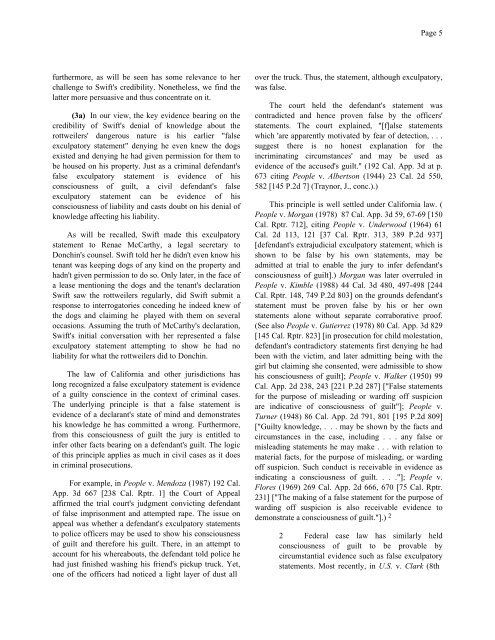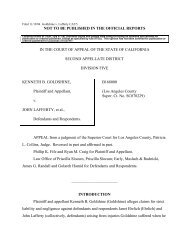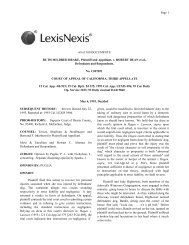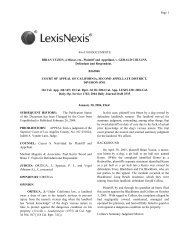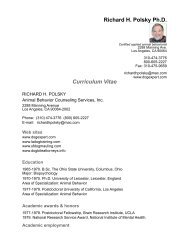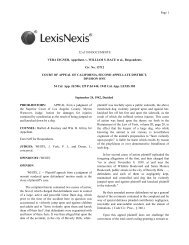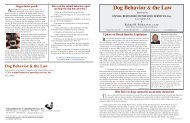Donchin v. Guerrero - Animal behavior dog bite expert witness
Donchin v. Guerrero - Animal behavior dog bite expert witness
Donchin v. Guerrero - Animal behavior dog bite expert witness
You also want an ePaper? Increase the reach of your titles
YUMPU automatically turns print PDFs into web optimized ePapers that Google loves.
Page 5<br />
furthermore, as will be seen has some relevance to her<br />
challenge to Swift's credibility. Nonetheless, we find the<br />
latter more persuasive and thus concentrate on it.<br />
(3a) In our view, the key evidence bearing on the<br />
credibility of Swift's denial of knowledge about the<br />
rottweilers' dangerous nature is his earlier "false<br />
exculpatory statement" denying he even knew the <strong>dog</strong>s<br />
existed and denying he had given permission for them to<br />
be housed on his property. Just as a criminal defendant's<br />
false exculpatory statement is evidence of his<br />
consciousness of guilt, a civil defendant's false<br />
exculpatory statement can be evidence of his<br />
consciousness of liability and casts doubt on his denial of<br />
knowledge affecting his liability.<br />
As will be recalled, Swift made this exculpatory<br />
statement to Renae McCarthy, a legal secretary to<br />
<strong>Donchin</strong>'s counsel. Swift told her he didn't even know his<br />
tenant was keeping <strong>dog</strong>s of any kind on the property and<br />
hadn't given permission to do so. Only later, in the face of<br />
a lease mentioning the <strong>dog</strong>s and the tenant's declaration<br />
Swift saw the rottweilers regularly, did Swift submit a<br />
response to interrogatories conceding he indeed knew of<br />
the <strong>dog</strong>s and claiming he played with them on several<br />
occasions. Assuming the truth of McCarthy's declaration,<br />
Swift's initial conversation with her represented a false<br />
exculpatory statement attempting to show he had no<br />
liability for what the rottweilers did to <strong>Donchin</strong>.<br />
The law of California and other jurisdictions has<br />
long recognized a false exculpatory statement is evidence<br />
of a guilty conscience in the context of criminal cases.<br />
The underlying principle is that a false statement is<br />
evidence of a declarant's state of mind and demonstrates<br />
his knowledge he has committed a wrong. Furthermore,<br />
from this consciousness of guilt the jury is entitled to<br />
infer other facts bearing on a defendant's guilt. The logic<br />
of this principle applies as much in civil cases as it does<br />
in criminal prosecutions.<br />
For example, in People v. Mendoza (1987) 192 Cal.<br />
App. 3d 667 [238 Cal. Rptr. 1] the Court of Appeal<br />
affirmed the trial court's judgment convicting defendant<br />
of false imprisonment and attempted rape. The issue on<br />
appeal was whether a defendant's exculpatory statements<br />
to police officers may be used to show his consciousness<br />
of guilt and therefore his guilt. There, in an attempt to<br />
account for his whereabouts, the defendant told police he<br />
had just finished washing his friend's pickup truck. Yet,<br />
one of the officers had noticed a light layer of dust all<br />
over the truck. Thus, the statement, although exculpatory,<br />
was false.<br />
The court held the defendant's statement was<br />
contradicted and hence proven false by the officers'<br />
statements. The court explained, "[f]alse statements<br />
which 'are apparently motivated by fear of detection, . . .<br />
suggest there is no honest explanation for the<br />
incriminating circumstances' and may be used as<br />
evidence of the accused's guilt." (192 Cal. App. 3d at p.<br />
673 citing People v. Albertson (1944) 23 Cal. 2d 550,<br />
582 [145 P.2d 7] (Traynor, J., conc.).)<br />
This principle is well settled under California law. (<br />
People v. Morgan (1978) 87 Cal. App. 3d 59, 67-69 [150<br />
Cal. Rptr. 712], citing People v. Underwood (1964) 61<br />
Cal. 2d 113, 121 [37 Cal. Rptr. 313, 389 P.2d 937]<br />
[defendant's extrajudicial exculpatory statement, which is<br />
shown to be false by his own statements, may be<br />
admitted at trial to enable the jury to infer defendant's<br />
consciousness of guilt].) Morgan was later overruled in<br />
People v. Kimble (1988) 44 Cal. 3d 480, 497-498 [244<br />
Cal. Rptr. 148, 749 P.2d 803] on the grounds defendant's<br />
statement must be proven false by his or her own<br />
statements alone without separate corraborative proof.<br />
(See also People v. Gutierrez (1978) 80 Cal. App. 3d 829<br />
[145 Cal. Rptr. 823] [in prosecution for child molestation,<br />
defendant's contradictory statements first denying he had<br />
been with the victim, and later admitting being with the<br />
girl but claiming she consented, were admissible to show<br />
his consciousness of guilt]; People v. Walker (1950) 99<br />
Cal. App. 2d 238, 243 [221 P.2d 287] ["False statements<br />
for the purpose of misleading or warding off suspicion<br />
are indicative of consciousness of guilt"]; People v.<br />
Turner (1948) 86 Cal. App. 2d 791, 801 [195 P.2d 809]<br />
["Guilty knowledge, . . . may be shown by the facts and<br />
circumstances in the case, including . . . any false or<br />
misleading statements he may make . . . with relation to<br />
material facts, for the purpose of misleading, or warding<br />
off suspicion. Such conduct is receivable in evidence as<br />
indicating a consciousness of guilt. . . ."]; People v.<br />
Flores (1969) 269 Cal. App. 2d 666, 670 [75 Cal. Rptr.<br />
231] ["The making of a false statement for the purpose of<br />
warding off suspicion is also receivable evidence to<br />
demonstrate a consciousness of guilt."].) 2<br />
2 Federal case law has similarly held<br />
consciousness of guilt to be provable by<br />
circumstantial evidence such as false exculpatory<br />
statements. Most recently, in U.S. v. Clark (8th


